All Saints Church
All Saints’ Church, Coddington stands in Chapel Lane a few yards from the former Wesleyan Chapel (now a private house).
The 13th-14th Century stone church was reconstructed in 1864. Coddington Church is a Grade II* listed building and one of the 17 Nottinghamshire churches listed in the guide “England’s Thousand Best Churches” by Simon Jenkins, because of its pre-Raphaelite decoration and glass.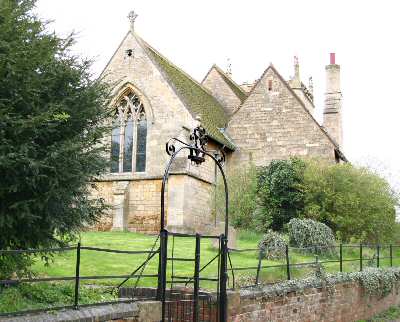
This article is about the church building. See separate articles for:
-
houses in Coddington named as old vicarages or parsonages.
A Church Guide, written by Michael Bache, is available for sale inside the church. For Heritage Open Day in 1999 Newark Archaeological Society also wrote a short leaflet describing the Burne-Jones and Morris Windows. A small picture of Coddington Church and its details from the National Monuments record can be found on the Images of England website. (images of england.org.uk)
Early Church History
Cottinton(e) is listed in the Domesday book and the principal owners were the Bishops of Lincoln and Bayeux. A church was not specifically mentioned in Domesday. A place of worship probably stood on the site of the church from Saxon times and the font itself may be Saxon.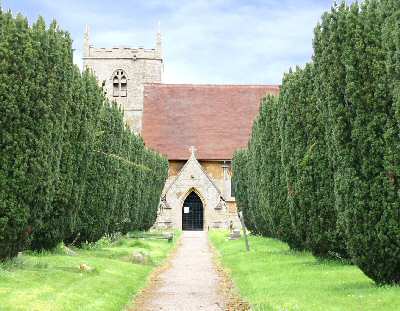
In 1911 Rev Atwell M Y Baylay wrote a paper for the Thoroton Society on Coddington Church. It describes the 13th century church as having a tower, nave with two side aisles and chancel (probably small). He believed the western lancet window, the font, the two arcades, the north and south doorways and the north lancet windows dated from the 13th century. As the beautiful east window and the south aisle window heads seemed a little later than the arcade, he deduced that the south aisle may have been widened not long afterwards to accommodate a chantrey chapel or that the whole south aisle might be somewhat later than the north. The circular arcades of the south aisle are 13th century, whilst the octagonal ones of the north aisle which have nail-head ornamentand little owls are later. Both arcades have expanded bases. There was a curious stone bench at the west end of the south aisle. The west windows of the two side aisles are 14th century.
A papal bulla plumbata of the 14th century was found in Coddington church a few years before 1867. It looked like a coin about the size of an old penny (1d), but had perforations for a silken cord that attached it to the document. The front had two heads, with the letters S.PA:S.PE (for St. Paul and St. Peter), with the pontiffs name on the back CLEMENS, PP:V. (The source, EG Wake’s History of Collingham and its neighbourhood was published in 1867.)
The Chantry of Henry de Codyngton
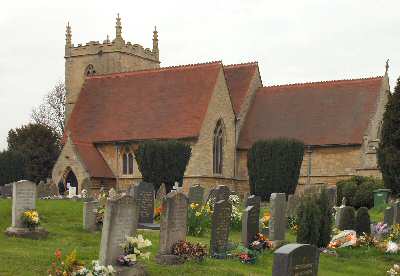 In 1404 Henry de Codyngton, parson of Bottesford having sought permission from Richard II, founded a chauntry at the altar of St Peter in our parish church. One priest was to pray for his soul and that of (his father) John de Codyngton, late Parson of Adesham, and for their family and benefactors. It was endowed with an estate in Coddington and Holme by Muskham of five dwellings, three tofts, 144 acres and 27 acres of meadow. John Ashwell was the first priest and his successors were to be named by the Prior of Thurgaton who had charge of the Chauntry (with the Prior of Shelford if he should fail). John de Codyngtons will proved in 1367 – has been found by Kent Archaeological society. John asks to be buried in one of three burial places, including our church if he die in the north, and his bequests include 60s to his son Henry and 6s 8d to Isabella Porter of Codyngton.
In 1404 Henry de Codyngton, parson of Bottesford having sought permission from Richard II, founded a chauntry at the altar of St Peter in our parish church. One priest was to pray for his soul and that of (his father) John de Codyngton, late Parson of Adesham, and for their family and benefactors. It was endowed with an estate in Coddington and Holme by Muskham of five dwellings, three tofts, 144 acres and 27 acres of meadow. John Ashwell was the first priest and his successors were to be named by the Prior of Thurgaton who had charge of the Chauntry (with the Prior of Shelford if he should fail). John de Codyngtons will proved in 1367 – has been found by Kent Archaeological society. John asks to be buried in one of three burial places, including our church if he die in the north, and his bequests include 60s to his son Henry and 6s 8d to Isabella Porter of Codyngton.
In 1552 Edward VI gave the chauntry to Sir Edward Bray, John Thornton and John Danby, and the heirs of the two latter after the Dissolution. Elizabeth I re-assigned it to Thomas Pocklington and heirs at the yearly value of 67s 4d. Baylay believed the chauntry altar was probably on the south side. The tower belfry windows and its parapets and pinnacles Baylay attributes to the late 15th century. Before the Victorian rebuilding there was also a beautiful clerestory and both aisles had lean-to roofs. There are also two pairs of ancient wooden bench-ends preserved in the north aisle.
Attached to East Stoke
Before the middle of the 19th century, Coddington Church was annexed to that of East Stoke and did not have a separate vicar. The names of two long-serving vicars have come down to us in our parish records:
-
1690 – 1714 Francis Clarke vicar
-
1719 – 1749 F Bainbridge vicar
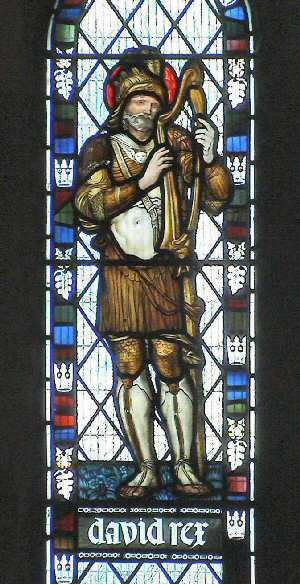 When the village lands were enclosed by an act of parliament in 1760, 213 acres were allotted to the vicar and prebendary of East Stoke Dr Charles Reynolds, with a further 30 acres to Thomas Wakefield, Vicar of East Stoke in lieu of tithes.
When the village lands were enclosed by an act of parliament in 1760, 213 acres were allotted to the vicar and prebendary of East Stoke Dr Charles Reynolds, with a further 30 acres to Thomas Wakefield, Vicar of East Stoke in lieu of tithes.
In the period 1801 – 1861 as many as 40 different curates or visiting ministers have signed the Parish register or officiated at services in Coddington church. In 1911 Baylay noted that church records only went back to Charles IIs time, the oldest register book having been lost in 1916 the register was said to go back to 1701. We have a handwritten notebook containing church vestry accounts from 1799 to the 1860s. Because there was no vicar the secular leaders in the village controlled these and had a large influence on vestry matters.
The curates who conducted church services often lodged with local farmers, such as the Booths who lived at the farmhouse on Balderton Lane (now called The Homestead). They included Rev Frederick Taverner (between 1855 and 1858) who left a detailed sketch map of the village, noting who lived where and how many children they had.
In 1844 the village population was listed as 436 and the church was described as an ancient building with tower and two/three bells. However the church and churchyard had fallen into disrepair and was even claimed to be unsafe. Meanwhile, the Wesleyans had established a chapel in 1827, then a school and were rapidly gaining prestige and influence in the village. The Wesleyan Day and Sunday School, for 100 pupils was built in 1858 (when the 1846 National School would only accommodate 80) and in 1865 they were to rebuild the village chapel, for 170 at a cost of £400.
A Full Parish at Last, Rev Dolphin and Church Rebuilding
A campaign was mounted and after long discussions with the church authorities Coddington became a full parish in 1860. The curate Rev Cooper Lewty became the first incumbent in 1860. In 1863 the new vicar, the Reverend John Maximillian Dolphin, replaced the Reverend Cooper Lewty. He went on to serve the parish for 27 years his initials are carved inside the porch near the roof. Whites 1864 trade directory says that the living was in the patronage of Lincoln Cathedral and was worth £90/year. James Thorpe, churchwarden, wealthy owner of Beaconfield and de facto village squire also gave Rev Dolphin £30 a year to preach an extra sermon on the Sabbath. In 1872 a trade directory valued the living at £102/year.
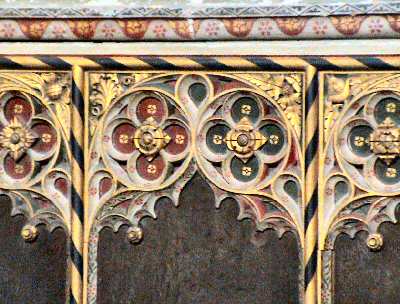 Rev Dolphin and the Thorpe family were largely responsible for the restoration of the church in 1864 – 65, work starting 6th June 1864. The architect contracted to oversee the work was G.F. Bodley, who involved the young partnership of Morris, Marshall and Faukner to decorate the church. The 1869 trade directory records that the rebuilding cost was £2,000, raised by subscription. The 45ft tower was encased in ashlar, windows and doorways were preserved but the south aisle was re-erected on the old foundations and the clerestory and chancel were destroyed. The tower and chancel arches date from the rebuilding. Not everyone was pleased: Baylay declares in 1911 it would be difficult to find a more glaring instance of a church being travestied in the name of restoration (Mr Bodley’s) early work, when he was still under the baleful influence of Sir Gilbert Scott and his school. Baylay criticises the high pitch of the nave and the south aisle roofs, noting the lack of tabling more appropriate to an area poor in building stone such as Sussex. His conclusion was: “architectural discord”.
Rev Dolphin and the Thorpe family were largely responsible for the restoration of the church in 1864 – 65, work starting 6th June 1864. The architect contracted to oversee the work was G.F. Bodley, who involved the young partnership of Morris, Marshall and Faukner to decorate the church. The 1869 trade directory records that the rebuilding cost was £2,000, raised by subscription. The 45ft tower was encased in ashlar, windows and doorways were preserved but the south aisle was re-erected on the old foundations and the clerestory and chancel were destroyed. The tower and chancel arches date from the rebuilding. Not everyone was pleased: Baylay declares in 1911 it would be difficult to find a more glaring instance of a church being travestied in the name of restoration (Mr Bodley’s) early work, when he was still under the baleful influence of Sir Gilbert Scott and his school. Baylay criticises the high pitch of the nave and the south aisle roofs, noting the lack of tabling more appropriate to an area poor in building stone such as Sussex. His conclusion was: “architectural discord”.
The tower is open to the nave and contains three rooms the lowest being the ringing chamber which also now houses the font. The font is covered by a heavy oak lid. Five bells were cast by Messrs Taylor & Co of Loughborough and set in an oak frame in 1867. The seating was of oak throughout. A handwritten note on Bodleys plans indicates that the Incorporated Society for the building etc of Churches and Chapels granted £70 towards rebuilding this church upon condition that 137 seats numbered 1-13 and 23-38 were reserved for the use of poorer 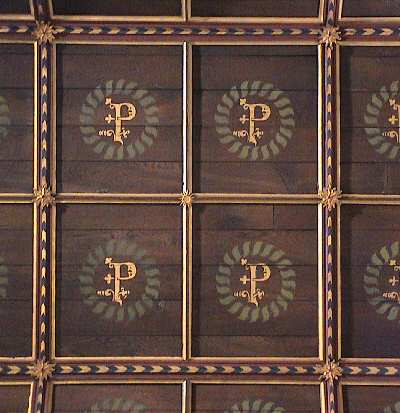 inhabitants. There was great concern in Newark in the 19th century over the lack of sufficient space within churches and the cost of church attendance to the poor. The organ chamber also served as a vestry whilst the organ, a gift from James Thorpe, was built by Messrs. Bevington. The vestry walls also incorporated some ancient sepulchral crosses, mostly from stone coffin lids.
inhabitants. There was great concern in Newark in the 19th century over the lack of sufficient space within churches and the cost of church attendance to the poor. The organ chamber also served as a vestry whilst the organ, a gift from James Thorpe, was built by Messrs. Bevington. The vestry walls also incorporated some ancient sepulchral crosses, mostly from stone coffin lids.
In the chancel Morris designed and painted the ceiling and wall panels, including a magnificent settle with gilded canopy. The firm’s early glass (1865), characteristically light and airy, is found in the chancel east window, the south side of the choir/chancel and in the tower lancet.
-
The East Window has three lights and tracery, with figures in three tiers in the side lights and a large crucifiction scene in the centre light with a small annunciation below it. The style is of 15th century Flemish glass, with yellow (silver) staining on white glass. The figures include some of the apostles, St Mary Magdalene, Lazarus’s sister Martha, St Stephen and St James. The window is dedicated to James Thorpe (father of the benefactor) who died in 1843.
-
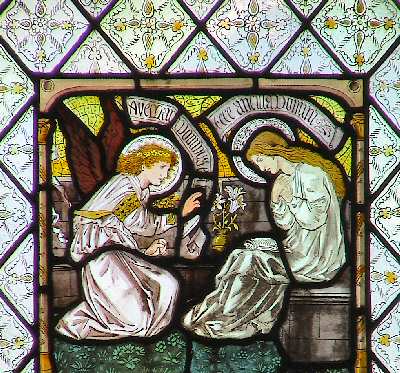 The South Chancel window has two lights and tracery. It depicts St Cecilia and St Catherine and was probably the one exhibited in 1864 at the South Kensington Stained Glass Exhibition. It is dedicated to Frances Spence of Tilworth who died in 1855. (James’s first wife Mary-Anne, was the daughter of E and Frances Spence. Mary died childless, after a long illness in 1868.)
The South Chancel window has two lights and tracery. It depicts St Cecilia and St Catherine and was probably the one exhibited in 1864 at the South Kensington Stained Glass Exhibition. It is dedicated to Frances Spence of Tilworth who died in 1855. (James’s first wife Mary-Anne, was the daughter of E and Frances Spence. Mary died childless, after a long illness in 1868.)
-
The tower lancet window shows John the Baptist. The colouring is richer than in the other early windows. Dated 1869, it cost £6 10s, plus 5s for packing. This window was restored in 1998 thanks to Michael Manser and the William Morris Society.
When they first worked on our church the firm of Morris, Marshall and Faukner, formed only in 1861, had just finished decorating Bodleys new churches at St Michael and All Angels Brighton, St Martins Scarborough and All Saints Selsley, Gloucester. They had not yet come to terms with the need for commercial attitude particularly in costing design work. It was around the time they moved out to Bloomsbury but before 1866 when they received the prestigious commissions for decorating a room at St James’s Palace and for the Green Dining Room at South Kensington (V&A) Museum. Typical windows of the 1860s consist of single figures and a background made up of uniform quarries with a striking pattern colour schemes were subtle with generous use of white and patterning of areas of clothing and the ground important. Highlights in yellow hair and Morris green produced from silver stain on blue grass were favourites. The firms designs for stained glass were mainly by Morris, Burne-Jones, Rossetti, Webb and Maddox Brown. Burne-Jones designs were more numerous and more popular with clients, but his cartoons for the firm were always uncoloured and the colour schemes were added by Morris.
We are fortunate that in the 1881 and 1882 James Thorpe again chose Morris and Co to provide more stained glass windows for the south aisle of our church.
-
Two 2-light windows depict St Elizabeth and St Anne, and King David and Samuel.
-
The east window has three lights and tracery, and depicts St Joseph, the Virgin Mary in blue with lilies, and St John. St Elizabeth and St Anne are by Ford Madox-Brown and the others by Burne-Jones and Morris.
The later windows show the richer pre-Raphaelite / Aesthetic colouring, though most of the cartoons are earlier designs.
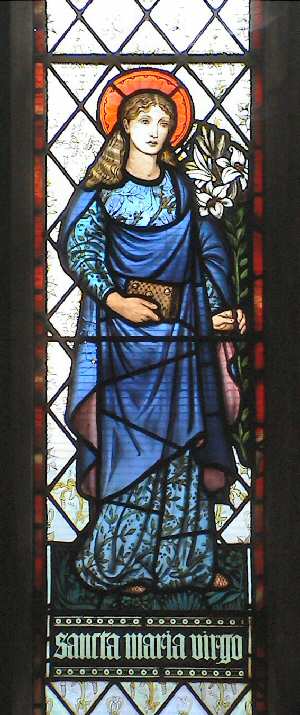 Whites 1872 directory states that a new parsonage is being built. The Ecclesiastical Commissioners built the vicarage in 1874 for £1,600 (£1,000 raised by subscription and a grant from Queen Annes Bounty). White’s 1885 trade directory says the living was valued at £300/year and was in the patronage of the Bishop of Southwell. In 1928 the living was said to be worth £309/year.
Whites 1872 directory states that a new parsonage is being built. The Ecclesiastical Commissioners built the vicarage in 1874 for £1,600 (£1,000 raised by subscription and a grant from Queen Annes Bounty). White’s 1885 trade directory says the living was valued at £300/year and was in the patronage of the Bishop of Southwell. In 1928 the living was said to be worth £309/year.
The 1879 trade directory states that services are at 11 and 3, with a Sacrament first Sunday of month. Churchwardens were J Thorpe and Ross, the organist Mr Dalgleish of Newark, using Hymns Ancient & Modern. Parish Clerk was Samuel Coleby. The church would seat 200. In 1890-92 Colonel James Thorpe paid £550 for the whole church to be wainscotted in oak and for an oak screen designed by GF Bodley.
The churchyard was enlarged and planted with ornamental shrubs in 1866 when the church was rebuilt. It has been extended several times taking in parts of what was the orchard of Charity farm. The first area in front of the South door was added between 1884 and 1900, presumably around 1890 when Chauntry-Hunt set an essay The new part of the churchyard for the 6th-7th standard schoolchildren.
Rev Penswick Smith, his daughter Constance and Mothering Sunday
In 1890 Rev Dolphin moved to Long Eaton and a new vicar, the Reverend Charles Penswick Smith, came to Coddington with his family. He was to serve until 1922, when the church became part of the larger United Benefice of Newark and Coddington. His daughter, Constance Penswick Smith (1878 – 1938) became a very independent woman. She travelled to Germany before working as a dispenser for the eminent doctor Dr Thomas Mallett of Park Row, Nottingham. With her friend Ellen Porter she became a tireless campaigner for 25 years for the revival of Mothering Sunday in Britain. 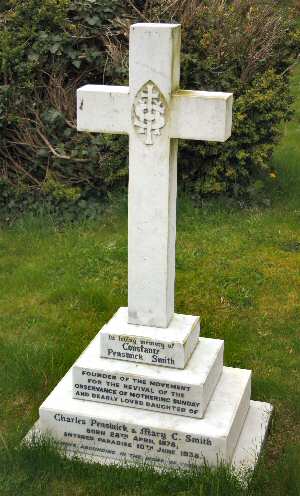 She was concerned that the religious aspects of the medieval mid-lent festival of Mothering Sunday would be overshadowed by the new American annual (‘Second Sunday in May’) Mother’s Day, begun in 1908 by Miss Anna Jarvis of Philadelphia to honour her own mother. Constance set up headquarters as the Mothering Sunday Movement at 15 Regent Street in Nottingham, designed Mothering Sunday cards, wrote plays and articles and books, and collected suitable hymns. Early converts included the Rev Killer of St Cyprians in Nottingham and Constance’s four brothers who had taken holy orders. You can find the Penswick Smith graves near the church porch. In 1951 the Lady Chapel and altar were dedicated in her honour. The Lady Chapel was originally designed with small pews as the area used for a children’s Sunday School.
She was concerned that the religious aspects of the medieval mid-lent festival of Mothering Sunday would be overshadowed by the new American annual (‘Second Sunday in May’) Mother’s Day, begun in 1908 by Miss Anna Jarvis of Philadelphia to honour her own mother. Constance set up headquarters as the Mothering Sunday Movement at 15 Regent Street in Nottingham, designed Mothering Sunday cards, wrote plays and articles and books, and collected suitable hymns. Early converts included the Rev Killer of St Cyprians in Nottingham and Constance’s four brothers who had taken holy orders. You can find the Penswick Smith graves near the church porch. In 1951 the Lady Chapel and altar were dedicated in her honour. The Lady Chapel was originally designed with small pews as the area used for a children’s Sunday School.
In 1900 GH Attenborough from Newark was the organist, whilst George Walster was the sexton (also parish clerk, joiner and cottager) he was still the sexton in 1916 and 1928. In 1911 Baylay notes that the new work (the chancel) has not stood well requiring substantial buttressing in recent years to prevent it falling.
In 1921 a marble tablet honoured the parish dead of World War I, and Mrs Thorpe gave one commemorating her husband Captn. John Somerled Thorpe JP and MC.
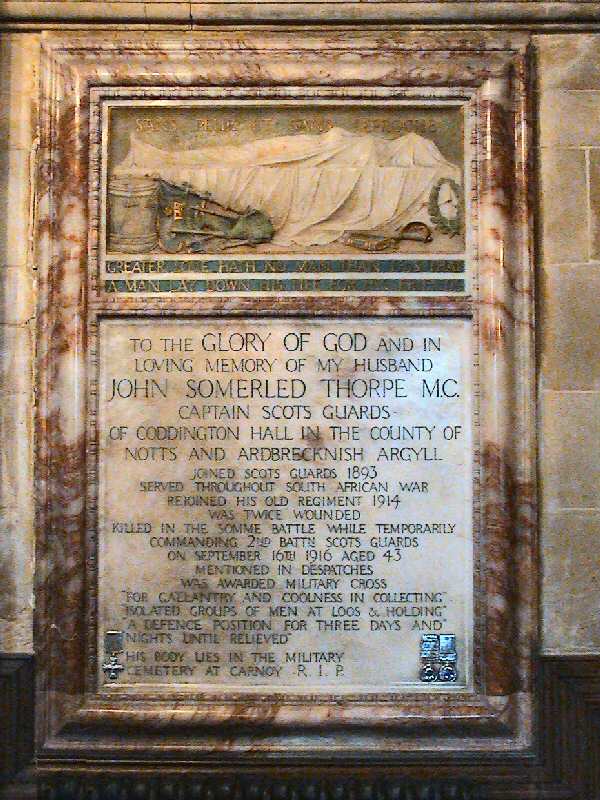
After World War I
In 1922 the Parish was united with St Mary Newark. Rev John Nutbrown, Rev Sydney Cyril Bulley and Rev BA Whitworth served up to end of the 1940s, with a further six vicars until 1961.
After 1961 the Parish was split from Newark and combined with that of Barnby and Rev Peter Wright was the first vicar. He achieved his ambition of outserving both his predecessors Rev John M Dolphin and Rev Charles Penswick Smith. Peter Wright retired in 1997 after 36 years. Peter Wright died in 2004 and was buried at Coddington – the Church packed and overflowing with villagers.
Our bells were notoriously difficult to ring. In the early 1960s the ringers raised £100 to fund an inspection by bellfounders Whitechapel (of London) and Taylors (of Loughborough). Extensive movement of the tower walls and a hairline crack in the west wall was discovered, causing bell ringing to be suspended. Funds were sought from The Barron Bell Trust and the Southwell Guild Repair Fund repairs, a new bell, repairs and rehanging as ring of six was estimated at £1,300. Taylors cast the new Treble bell, a new steel frame was built and the dedication service took place on 15th November 1965. The ropes were last replaced in 1997. See a list of bellringers here (insert link)
In 1998 the Church was rewired. Mr Manser funded the refurbishment of the Morris window of St James in the Belltower.
